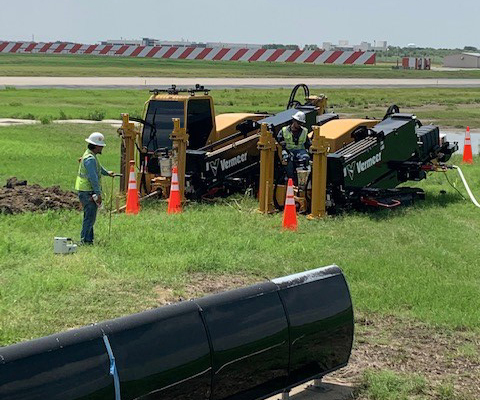The bore plan called for the crew to drill deep — 48 feet (18.6 m) below the surface, to be exact. “In populated areas, inadvertent returns can lead to more issues than in more rural areas,” explained Aaron. “Boring deeper gave us a lot more ground cover to help avoid this from happening. And, the ground was a soft clay, so keeping our returns was a huge battle for us.”
Dakota Utility Contractors employ mud engineers to handle the drilling fluid management side of the operations on big jobs like this one. The challenge on the Frisco job was coming up with a way to maintain the drill path’s integrity, keep the clay from balling up and causing an inadvertent return, and minimize flow to the exit side of the bore.
“We were crossing several intersections, so we couldn’t pump slurry back to the mud recycling system. It had to be hauled with vacuum excavators,” explained Aaron. “To delay flow to the exit side, we performed the pilot bore and the first couple of reamer passes without punching out, so the fluid only had one way to go. Our onsite mud engineer monitored our fluid returns to make sure we were getting the majority of it back and made adjustments to our drilling fluid mix when needed.”
Before pulling back the 20-inch (50.8-cm) HDPE pipe, the bore was opened up to a 30 inch (76.2 cm). After the pilot bore, the crew push-reamed with a 18-inch (45.7-cm) mill-tooth, roller-cone reamer. After the first pass, they tried to step up to a 30-inch (76.2-cm) reamer, but the returns were too thick and the clay was balling up, which was pulling down their rate of returns. To avoid a potential inadvertent return, they swapped out that reamer with a 24-inch (61-cm) reamer and then stepped back up from there. On the final pass, the crew punched out and made two swab passes before pulling back.
Aaron said from start to finish his crew was on the job for less than a month and were able to successfully avoid any inadvertent returns.
Rowlett water relocation project
While one team was wrapping up the Frisco job, another one of Dakota Utility Contractors’ crews performed a 1,400-foot (426.7-cm) pilot bore in Rowlett for a water line relocation project with a Vermeer D100x140 S3 HDD. Plans to expand the nearby road from two lanes to four prompted the project, and the site sat right between a causeway and a lake.
The D100x140 S3 would later be swapped out with the larger D220x300 S3 to ream and pullback the 30-inch .500 (12.7 mm) wall steel casing. Aaron said that on several large-diameter projects under 2,000 feet (609.6 m), they use their small drills to do the pilot bore and make a reamer pass or two because it helps reduce their operational costs. Then when it’s time to open the hole wider and pull, they move in the D220x300 to complete the job.
With water on both sides of the jobsite, the ground conditions were a combination of really wet sand and clay. This pairing kept the project’s mud engineer busy changing the fluid mixture through the bore’s length. After punching out on the pilot bore, the crew ran a tail rod throughout the reaming process.
“The ground conditions made everything touch-and-go,” said Aaron. “In the clay, we pulled and pushed ream, and then in the sand areas, we would go all the way through. We had to fight conditions the whole way. We were all anxious to get this one done.”
Keeping busy
As all of Dakota Utility Contractors’ crews crisscrossed the country performing utility and large-diameter bores, Aaron took a minute to reflect on what got the company to where it is today. “We’ve been working with the same core customers almost from the beginning. They know us and trust that we’ll always do an excellent job for them. We have also been successful at retaining our talented crew members and have several celebrating their 10-year and 15-year anniversaries.
“And finally, we’ve invested in quality equipment and have great partnerships with the people at the dealership,” he finished. “We purchased our first drill from Vermeer Texas-Louisiana, and they’ve been supporting us ever since. All of those factors have taken us to where we are today and will be tomorrow.”



